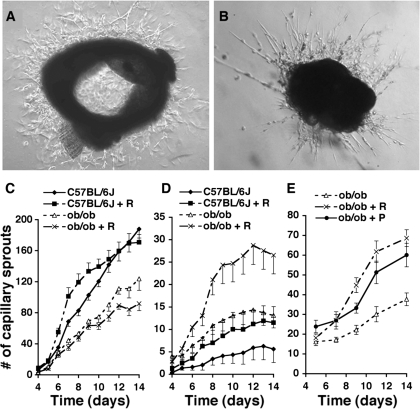Fig. 2.
Analysis of capillary sprout formation from aorta and epididymal fat pad explants. A and B: representative photomicrographs of capillary sprouts formed from aorta explants of C57BL/6J mice (A) on day 7 or epididymal fat pad explants of ob/ob mice (B) on day 14 of culture. Magnification is ×40. C–E: quantitative analysis of capillary sprout formation from aorta (C) or epididymal fat pad explants (D and E) from mice treated with RSG (+R) or pioglitazone (+P). Sprout formation was significantly (P < 0.05) decreased in aortas from ob/ob mice compared with C57BL/6J mice. No significant effect of RSG feeding of either C57BL/6J or ob/ob mice on aorta sprout formation was seen. In each experiment, each aorta was divided to 7–12 ring explants, and 4 independent experiments were performed. Total number of explants was n = 41 for C57BL/6J, n = 39 for C57BL/6J + RSG, n = 46 for ob/ob, and n = 45 for ob/ob + RSG. Sprout formation from fat pad explants was significantly increased by RSG feeding of both C57BL/6J (P < 0.01) and ob/ob mice (P < 0.001). A significant increase (P < 0.01) in sprout formation from explants from C57BL/6J compared with ob/ob mice was seen. For each experiment, ∼20 explants from each experimental group were embedded and counted, and 3–5 independent experiments were performed. Total number of explants in D was n = 72 for C57BL/6J, n = 69 for C57BL/6J + R, n = 123 for ob/ob, and n = 117 for ob/ob + R. Total number of explants in E was n = 94 for ob/ob, n = 88 for ob/ob + R, and n = 92 for ob/ob + P. Data were analyzed by 1-way ANOVA, followed by Tukey's multiple comparison test.

